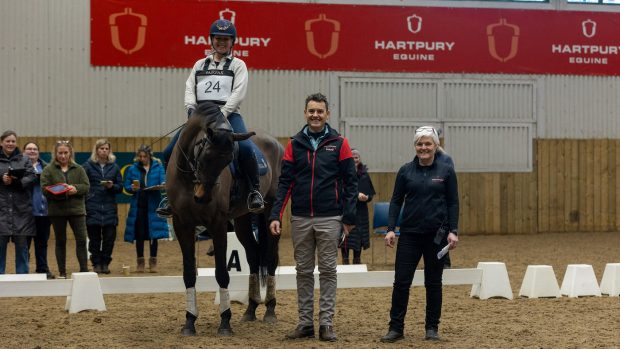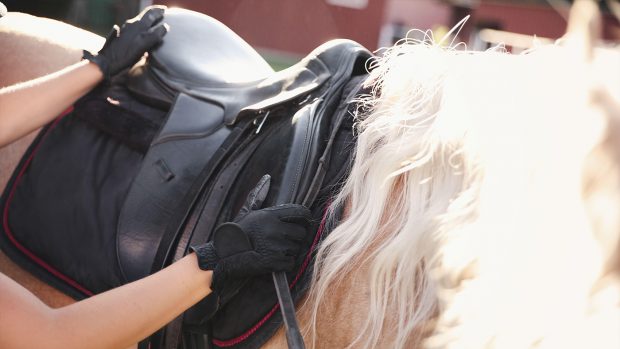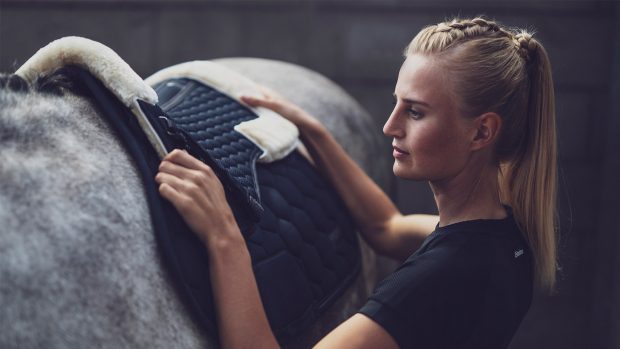A badly fitted saddle can rub a horse over 4,000 times in one hour-long ride. The pain this can cause will often lead to behavioural problems which are sometimes severe enough to be dangerous.
So, for your horse’s comfort and your safety, it’s important to have your saddle fitted by a qualified saddle fitter – this is more important than them being a Master Saddler.
The Society of Master Saddlers runs the only qualifications for saddle fitters. They can supply you with a list of qualified fitters who carry an ID card, have to re-register with the Society every year and complete a refresher course every two years.
Kirsty Oxby, from Frogpool Manor, one of the largest saddle suppliers in the south east, says a big mistake many people make is assuming that a saddle fitter should be a Master Saddler.
“Master Saddlers are not necessarily qualified saddle fitters,” she says. “It’s a bonus if your saddle fitter is a Master Saddler as he will know the workings of a saddle, but it is not a necessity – being qualified in fitting is.”
Pat Crawford, spokesperson for the Society of Master Saddlers, confirms there may be times when an ethical saddle fitter will not want to fit a saddle because there is a problem with the horse’s back. “The fitter will then recommend you call in the vet or physiotherapist. Remember the fitter is there to recognise a problem, not to diagnose it.”
For a list of qualified saddlers – the craftsmen who make them – and qualified saddle fitters – the people who fit them – in your area, contact the Society of Master Saddlers on (01449) 711 642. The Society also offers advice and can answer queries.
Booking an appointment
If you are buying a new saddle the fitting is most often free of charge, but you will usually be charged for a second-hand fitting.
Some saddle fitters have facilities for you to take your horse to them, saving a call out fee and giving you a bigger choice of stock.
When you book an appointment for a home visit give information so the fitter can bring an appropriate selection.
- Start with your full name and address and clear details of how to find your premises – this sounds basic, but is easily overlooked!
- Give a full description of the horse: the type – whether he’s a Thoroughbred, cob or native pony; condition – fit and well muscled or in poor or soft condition; height and general conformation. If you are unsure how to describe your horse ask your instructor or another experienced person.
- Provide some idea of the wither profile of your horse – either high and narrow like most Thoroughbreds, or flat like a typical cob.
- Inform him of the main disciplines you intend to do. A general purpose (GP) saddle is best for most leisure riders, but there are various styles. A GP won’t be as good as a specialist saddle for specific disciplines, but it’s better to have a properly fitted GP saddle than two inferior specialist ones.
- Give some details of the main user of the saddle – sex, weight and build. Point out if the saddle is going to be used by several different riders as the saddler will then find a saddle which is suitable for the largest rider.
- Let him know the standard you are riding at and the standard of your horse.
- Don’t attempt to guess at the size of saddle you think your horse will need. Leave it to the expert as sizes vary tremendously depending on the make of the saddle.
- Indicate how much you intend to spend and whether you would prefer to buy a second-hand or new saddle.
On the day
You can trust your saddle fitter if he sticks to the following procedure and is a member of the Society of Master Saddlers – they will carry an ID card.
The saddle fitter should introduce himself to your horse, making sure your horse fits the description you gave him.
He should then check your horse’s back is in good condition, ie free from injury and sensitivity. He’ll then want to see the horse stood up outside. Again the fitter will confirm your horse’s description and look for injury, sensitivity and soreness on his back.
The fitter will also look for signs of assymmetrical muscle development. No horse is completely symmetrical and slight adjustments to flocking can compensate for this, but if there is a pronounced difference it may need investigating.
The fitter will then ask for your horse to be trotted up so he can check for levelness and muscle development. Many horses have one big shoulder, which can make a saddle sit crookedly.
Next, the saddle fitter will try various saddles he thinks may fit. These will be put on the horse, without a girth. Some will be discarded, and those left will be attached with a girth.
Ultimately you’ll be left with a couple to ride in.
When you’ve tried them – you should be given time to walk, trot and canter on each rein and pop over a jump if appropriate – each will be discussed and the fitter will look at the mark left by each on the back, to see if they’ve slipped.
- A good saddle fitter will explain what he or she is doing. If you don’t understand, then ask. The fitter will also keep records of the fitting, including a description of your horse, conformation and movement and details of the saddle you buy. He can then refer to these records if you contact him in the future.
- You should be pleased with the saddle you buy and satisfied that a professional job has been done.
Preparing for the saddle fitter’s visit
Make sure the saddle fitter can do his job properly by:
- Bringing your horse in from the field and having him clean and dry.
- Setting aside somewhere to test the saddles, like a manage. Set up a few small jumps if necessary.
- Ensuring there is a level surface and adequate lighting.
- Allowing plenty of time for the fitting – it could take a few hours.
Read moresaddle fitting advice:




